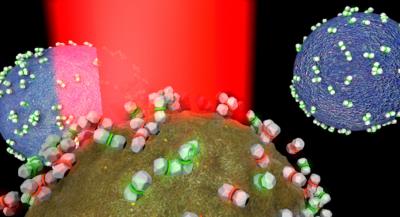UC Santa Barbara researchers have developed a novel technology for distinguishing prostate cancer cells in bodily fluids. The technology holds potential for developing a microdevice that would help understand when metastasis of prostate cancer would occur.
When there is more number of cancer cells in a patient’s blood the prognosis is worse. In prostate cancer patients, death is caused by metastasis and not by the primary tumor. Finding and recognizing cancer cells within bodily fluids could help in diagnosis and treatment for the cancer.
 Cancerous and non-cancerous cells are incubated with silver nanoparticle biotags, and then analyzed by shining the red laser on them. The biotags are shown on the cells' surface. Those glowing red in the middle are the cancer biomarkers, and those glowing green are standard biomarkers that bind to many cell types. A high ratio of red to green is found on the cancer cells. Credit: Gary Braun and Peter Allen/UCSB
Cancerous and non-cancerous cells are incubated with silver nanoparticle biotags, and then analyzed by shining the red laser on them. The biotags are shown on the cells' surface. Those glowing red in the middle are the cancer biomarkers, and those glowing green are standard biomarkers that bind to many cell types. A high ratio of red to green is found on the cancer cells. Credit: Gary Braun and Peter Allen/UCSB
UCSB researchers employed surface enhanced Raman spectroscopy (SERS), a kind of laser spectroscopy, and silver nanoparticles as biotags for this technique in order to differentiate between non-cancerous cells and cancerous cells. When silver nanoparticles absorb laser light they have the ability to emit a set of colors. This emission is not fluorescent.
The researchers are trying to add more markers for identifying unique tumor cells which are not like the main tumor cells. They intend to mix nanoparticles with cancerous cells and then pass them through a laser. The cells would then be differentiated by their signal ratios.
The team used two kinds of biotags. One type binds to both non-cancerous and cancerous cells, while the other has an affinity to neuropilin-1, a cell receptor that is found on certain types of cancerous cells. The researchers mixed the two types of biotags and then added them to cultures of cancerous and healthy cells. In the analysis, an average SERS signal provided a signal ratio that was consistent with the known identity of a cell.
The findings of the study have been published in Proceedings of the National Academy of Sciences.